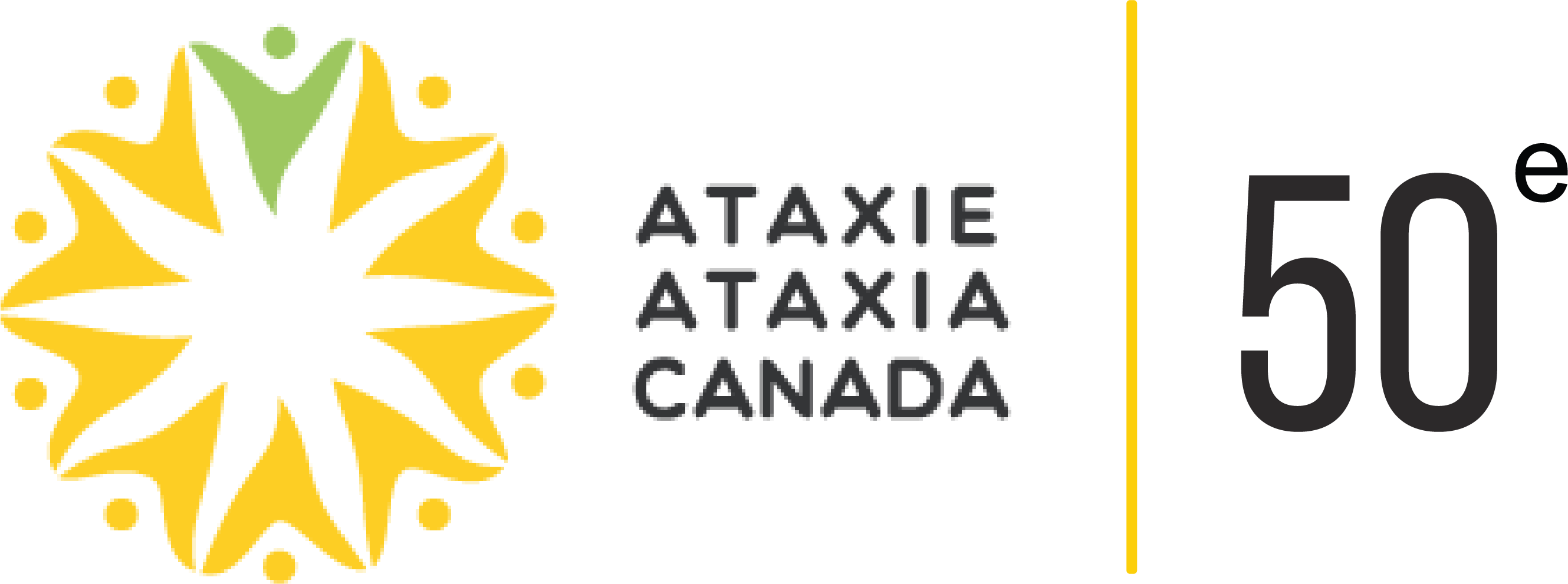They are over 50 types of genetically identified SCA’s, here is a brief description of the most common that account for over 80% of all cases
Spinocerebellar ataxia type 1 (SCA1)
What is SCA1?
SCA1 is a degenerative neurologic disease. It is first characterized by cerebellar deterioration which leads loss of motor function and coordination. It starts most often during a person’s thirties or forties (though cases later or during childhood can be found). More severe forms affect children. The age of onset and the progression of SCA1 are variable even within the same family.
Symptoms
Balance problems and incoordination are typically the first visible symptoms of SCA1. Over time, it is possible to developpe swallowing problems and slurred speech. Certain cases may developpe certain other symptoms; such as nystagmus neuropathy (loss of feeling and reflexes in the limbs), spasticity, muscle atrophy and memory loss.
Transmission
It is a dominant autosomal disease; it affects both sexes and only one parent must transmit the gene to have a child affected by the disease. Children of an affected individual have a 50% chance of inheriting the disease.
Treatments
There are no treatments for SCA1, but technical aids can help prevent falls and certain medications can help with certain symptoms such as spasticity.
Occupational therapy, physiotherapy, and speech therapy can be done in order to limit functional losses and to prevent certain complications.
There are some ongoing clinical trials as well.
NAF research link:
https://ataxia.org/help-develop-new-treatments/#spnclinicalTrials
Sources:
https://ataxia.org/wp-content/uploads/2019/04/SCA1.pdf
https://www.ncbi.nlm.nih.gov/books/NBK1184/
Spinocerebellar ataxia type 2 or Olivo-Ponto cerebellar atrophy (SCA2)
What is SCA2?
SCA2 is a genetic degenerative cerebellar ataxia. It affects the cerebellum and causes balance and coordination problems. Its onset is usually during a person’s forties.
Symptoms
SCA2 symptoms include coordination and balance problems. Loss of feeling and loss of reflexes as well as slow eye movements are some of the first noticeable symptoms. Muscle cramps and tremors can developpe too. Slurred speech, difficulty swallowing, and excessive muscle slackening might occur over time.
Transmission
It is a dominant autosomal disease; it affects both sexes and only one parent must transmit the gene to have a child affected by the disease. Children of an affected individual have a 50% chance of inheriting the disease.
Treatments
There are no treatments for SCA2, but technical aids can help prevent falls.
Occupational therapy, physiotherapy, and speech therapy can be done in order to limit functional losses and to prevent certain complications.
There are some ongoing clinical trials as well.
NAF research link:
https://ataxia.org/help-develop-new-treatments/#spnclinicalTrials
Sources:
https://www.ncbi.nlm.nih.gov/books/NBK1275/
https://ataxia.org/wp-content/uploads/2019/04/SCA2.pdf
Machado-Joseph disease or spinocerebellar ataxia type 3 (SCA3)
What is SCA3?
SCA3 is a hereditary cerebellar ataxia that causes a degeneration of the cerebellum. There is damage created to the nerve cells and fibers that lead to the cerebellum’s damage. It starts most often during the middle of adulthood (though cases later or during adolescence can be found). The age of onset of SCA3 is due to the gene causing the disease.
Symptoms
Balance problems and incoordination are typically the first visible symptoms of SCA3. Over time, slurred speech will become noticeable. Certain cases may developpe certain eye troubles, such as double vision and slow eye movements. With the progression of the disease, spasticity, muscle loss are usual symptoms.
There are no treatments for SCA3, but technical aids can help prevent falls and certain medications can help with certain symptoms such as spasticity.
Transmission
It is a dominant autosomal disease; it affects both sexes and only one parent must transmit the gene to have a child affected by the disease. Children of an affected individual have a 50% chance of inheriting the disease.
Treatments
Occupational therapy, physiotherapy, and speech therapy can be done in order to limit functional losses and to prevent certain complications.
There are some ongoing clinical trials as well.
NAF research link:
https://ataxia.org/help-develop-new-treatments/#spnclinicalTrials
Sources:
https://ataxia.org/wp-content/uploads/2019/04/SCA3-MJD.pdf
https://www.ncbi.nlm.nih.gov/books/NBK1196/
Spinocerebellar ataxia type 6 (SCA6)
What is SCA6?
SCA6 is a degenerative neurologic disease. It is first characterized by cerebellar deterioration which leads loss of balance and coordination. It starts usually in a slow and progressive manner during adulthood.
Symptoms
Balance problems and incoordination are typically the first visible symptoms of SCA6. With the progression of the disease, sa person affected by SCA6 will developpe slurred speech. In about 50% of cases, a person will have vision problems, such as double vision. In later stages of the disease, chocking can become frequent.
Transmission
It is a dominant autosomal disease; it affects both sexes and only one parent must transmit the gene to have a child affected by the disease.
Treatments
There are no treatments for SCA6, but technical aids can help prevent falls and certain medications can help with certain symptoms such as Acetazolamide to eliminate episodes of ataxia.
Occupational therapy, physiotherapy, and speech therapy can be done in order to limit functional losses and to prevent certain complications.
There are some ongoing clinical trials as well.
NAF research link:
https://ataxia.org/help-develop-new-treatments/#spnclinicalTrials

